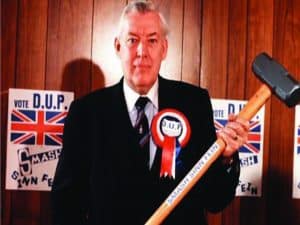The threat to ‘destroy’ a whistle-blower
The Reverend Ian Paisley, who served as First Minister of Northern Ireland (NI ), 2007-2008, was aware of the sexual abuse of boys which took place at Kincora Boys Home during the 1970s. Paisley learnt about it from Valerie Shaw, who served as secretary of the ‘missionary council’ of his church, on 28 October 1973.
Shaw denounced Paisley at a press conference in 1982: “I approached Dr Paisley on at least seven occasions”, she said. “I asked him time and time again what he intended to do about this. My concern all along was very much for the fact that there were young boys under the threat of this man’s corruption”.
The man she was referring to was William McGrath, the ‘Housefather’ at Kincora, and a long-time associate of Paisley before they fell out in the 1970s. Some of the RUC officers who investigated Kincora came to refer to him as ‘The Beast’. What has now emerged is that Paisley also participated in the cover-up of the scandal in the early 1980s. Many of the residents at Kincora were raped by McGrath, Joseph Mains and Raymond Semple, all of whom were convicted in December 1981. Others got away. These included Paisley’s former bodyguard, John Dunlop McKeague, a sadistic Loyalist paramilitary serial killer. Another was Pastor Willie Mullan, an Evangelical friend of Paisley. Paisley conceded that Valerie Shaw had informed him about McGrath’s reign of terror, although not that he worked at Kincora. “Yes, she did say – she made accusations against Mr McGrath – and she based these on the evidence of Mr ‘X’. When I met Mr ‘X’, he would not meet Mr McGrath and I of course did the only thing I could do: I put (sic) Mr McGrath from taking part in an Orange [Order] service in my church. He wasn’t a member of my church but I took that discipline immediately; and I regret Miss Shaw didn’t go to police”.
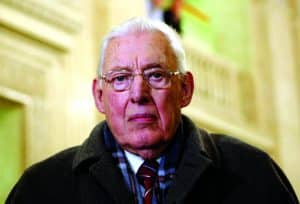
Shaw, however, had gone to the RUC but had recieved no help.
Shaw also informed two senior figures at the Church who warned her Paisley would “destroy” her if she persisted in her campaign.
Shaw’s efforts to engage Paisley lasted a year and a half, after which she left his church in disgust.
Belying the distance Paisley alleged he placed between himself and McGrath, Paisley went on to officiate at the wedding of McGrath’s daughter, Elizabeth, on 22 January 1976. It should be stressed that Ian Paisley was not a child abuser. However, his actions were motivated by other factors, none of which can have been benign.
(A 25,000 word account of the Anglo-Irish Vice Ring of which Kincora was a part is available as an addendum to a story on this website entitled: ‘Johnson will defer to the Establishment but Corbyn will blow the lid’. It starts with an account of Lord Louis Mountbatten’s involvement in the rape of boys from Kincora Boys’ Home in Belfast.)
Mr. ‘X’
Mr. ‘X’ was Roy Garland, who had served in Tara, a paramilitary organisation led by McGrath. As part of his mission to expose McGrath, Roy Garland also informed Brian Gemmell, a conscientious British military intelligence officer about Kincora. The information was passed along the line to Ian Cameron of MI5 who ordered Gemmell to abandon his inquiries. Cameron gave this order because MI5 was blackmailing some of the Kincora abusers and exploiting the heinous behaviour there in other ways.
Richard Kerr, the witness who joins all the dots
Richard Kerr is the key figure in appreciating the full extent of the scandal. His horrific experience joins the dots between all of the key figures and developments involved in it.
Kerr was born on 12 May 1961, and lived with his family off the Botanic Gardens in Belfast until he was placed into care at Williamson House (WH) in North Belfast on 16 December, 1966. WH catered for Catholic and Protestant children. Kerr was abused by Eric Witchell from the age of 8, starting one night after Witchell visited his bed.
“I was on my side, I had a teddy bear. I was biting into that while he had his hand down my backside and fumbled around”. Full rape commenced later. Years later, Witchell was jailed for abusing other boys at WH.
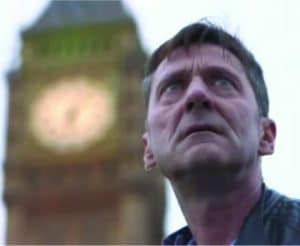
Kerr has informed Village that Witchell became the head of WH “for the Catholics’ side in early 1975 while I was there. Before that he was visiting it and from my memory he was working part-time. He was living in Liverpool at a church, but had his own place in Belfast that he would go to when he would visit Williamson House”. Witchell, he adds, arranged “for me to meet him in the Liverpool at a church; then he abused me there. I was still in care, living in Belfast.
But please realise there were others who came to WH who abused us”. One of the “others” who abused the children at WH was Dr Morris Fraser. Both Witchell and Fraser are alive and there is no sign yet that either of them will ever be prosecuted by the PSNI for the abuse of Kerr.
“My school records from Mount Vernon”, Kerr has also told Village, “were destroyed because it contained information indicating that I was being abused at Williamson House. The staff at the school suspected I was being abused but, when asked, I would not answer their questions because I was afraid of my abusers”.
Her Majesty’s child brothel at Kincora
In 1975 Kerr was sent to Kincora. He was only 14 and became its youngest resident. He was forced to have sex with Joseph Mains, the Warden of Kincora, in the shed at the back of the home which “had a chair and a mattress in it, that’s about all”, and in a hotel and a guesthouse. Witchell continued to abuse him. “Eric was a good friend of Mains” and they were often on the phone together. “Eric would call Mains and I would speak to him on the phone when I was in Kincora and [he would ask] me to come over to Williamson House; then he would abuse me. His room was on the top floor”. Kerr had no choice but to submit to Witchell if he wanted to see his sister at WH.
At the age of 15 Kerr was taken to the Whip and Saddle bar at the Europa Hotel by Mains and others who supplied him to men staying at the hotel.
The deeply flawed conclusion of the 2017 Hart Report was that abuse at Kincora was an isolated aberration limited to a handful of miscreants on its staff. Significantly, while Kerr was at Kincora, he was spirited out of Ireland to Manchester, London and elsewhere. He has supplied Village with a photograph taken of him aged 16 in London. This photograph alone sinks the central finding of the Hart Report.
Witchell introduced him to two men who exploited him in Manchester. Abuse took place at the Rembrandt Hotel and elsewhere. The two men “had other boys living with them. They took photographs of us tied up with our clothes off to put in boys’ magazines. They said they were sending some to Amsterdam”.
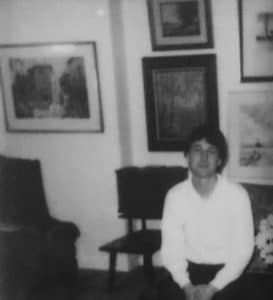
The Whip and Saddle Bar at the Europa Hotel
In June 1977, when he was 16, Joe Mains secured a job for Kerr at the Europa Hotel. He was rostered to work in the “late evening”. This was an excuse to make him available to abusers, many of whom congregated at the Whip and Saddle bar.
Harper Brown, the manager of the Europa Hotel, 1971-84, was a “very, very good friend” of Mains’ and Kerr has no doubt he “knew what was going on there”. Kerr’s employment lasted until October 1977.
“I met Englishmen and Americans at the Europa Hotel where I was abused. Some of these men arranged for me to meet them in England. I was also taken to Larne many times where I was abused at the Harbour Inn Hotel. I was also transported to Scotland from Larne and taken to the North of England and London. This happened quite a bit. I was taken there many times by men who were in the Orange Order. They would come up to Kincora. Two of these men did not abuse me but would take me to meet men that did”. Kerr knew they were Orangemen from discussions with Mains. “When I was in Mains’ room in the late evening and he was drinking he would tell me about his membership in the B Specials, and also about the men he knew in the Orange Order. I met one of these men before Kincora and I met the other two when they came to Kincora. They would take me out to places and they would become intoxicated and would have conversations about the Orange Order. I remember one of them said that he was a member of the club behind the West Circular Road. Mains would write down a false address of where I had been to cover-up where they would take me”.
Joe Mains and Sir Maurice Oldfield of MI6
In 1980 MI5 (which is attached to the British Home Office) carried out an inquiry into the conduct of the former Chief of MI6, Sir Maurice Oldfield, 1973-78. MI6 is attached to the Foreign Office. This happened because Oldfield had been caught lying about his homosexuality. Oldfield was also an abuser of ‘rent boys’, underage male prostitutes. MI6 reviewed their files relating to the matter in 2011. According to the Hart Report, “Officer G” of MI6 “examined four ring binders with material relating to Sir Maurice Oldfield, including the 1980 MI5 investigation”.

Officer G proceeded to describe a “relationship” Oldfield had “had with Kincora boys’ home (KBH) in Belfast”. Oldfield was linked to Kincora “through his friendship with the KBH Head”. Hart concluded that this was not evidence of MI6 involvement in Kincora because Officer G had made a mistake and was apparently merely referring to allegations about a relationship. However, neither MI6 nor the Hart Report quoted a single contemporaneous report alleging a friendship between Oldfield and Joseph Mains, the only man who fits the description of “KBH Head”. Indeed, Village can find no trace anywhere of such a report, nor one about a friendship with any of the other staff members at Kincora.
Hart failure
There is an error at paragraph 607 of Chapter 29 of the Hart Report which was published in 2017 where it is stated that: “As we have explained, Richard Kerr has alleged that he was sexually abused by Sir Maurice Oldfield”. This is not accurate. Indeed, at paragraph 159 of Chapter 26 of the Report, the following appears: “Kerr did not know at the time who Oldfield was, he says, and does not suggest that he abused Kincora boys”.
Mains makes trouble with the RUC vanish
Kerr came to the attention of the police in October 1977 over an incident involving a car. He had been in the company of some older men who had left it behind, possibly after it had suffered damage to a bumper. After they departed, Kerr was picked up by the RUC. An investigation into the events of that night threatened to unravel the vice ring. “I was taken to the police station in October 1977. They allowed me to privately speak to Joseph Mains but the police officers were not in the same room. Joseph Mains told me as long as I kept my mouth quiet about what was going on, he would get me out of the situation I was in. There was a statement that was meant to be signed; I could not read so if I signed the statement, I did not know what I was signing. Joseph Mains ended up signing the statement as well”.
The statement Kerr signed made him appear a full year older than he was. Mains knew Kerr’s date of birth perfectly well, as of course did Kerr. Kerr believes “they were trying to cover-up by saying I was the driver of the car but it was actually the older men. I was 16, and back then you could only drive when you were 17”.
The Chairman of Belfast Corporation Welfare Committee
Two of Richard Kerr’s social workers became aware of what was going on and tried to get the authorities in Belfast to intervene but they met a blank wall because of abusers like Joshua Cardwell. He was Chairman of Belfast Corporation’s Welfare Committee which was responsible for Kincora. He was also a friend of Mains. Another key figure was a legal official who helped suppress the scandal, also an associate of Mains.
Kerr knew Cardwell as “Joseph” Cardwell and recalls that he wore a “funny” hat and drove a blue minivan. He does not believe that he “owned the minivan but one was provided for him and others as transportation for outings out of Kincora”. Cardwell took his victims to the Adelphi Hotel in Portrush. Kerr recalls the “evening bar” was “down the stairs back then”. He was plied with alcohol by abusers, there.
Cardwell committed suicide in March 1982 after being interviewed by the RUC about Kincora.
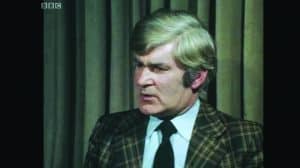
The sadistic paramilitary serial killer
The Park Avenue Hotel was another venue of abuse for Kerr. Mains “went there a lot”, according to Kerr. RUC men frequented it too, he recalls. Significantly, Kerr has revealed that “John McKeague and other men” were patrons too. McKeague’s group would occupy the “red seats in the bar area”. Kerr would be sent to a room to await abuse.
McKeague was born in 1930, and originally hailed from Bushmills, County Antrim. He came to Belfast after his parents, Isabella and Thomas, moved him and his sisters there from Portrush where they had run a guesthouse.
Over time McKeague became a sadistic sectarian serial killer, with a penchant for torturing victims before finishing them off. He was also obsessed by the Occult, and particularly by one of its practitioners, Evan Frederick Moran, the second Viscount Tredegar. Tredegar, who often visited Ireland, was even reputed to have been an enthusiastic and willing plaything for paedophiles at Buckingham Palace while serving there as a pageboy. Tredegar visited Lord Louis Mountbatten in Classiebawn, County Donegal, during some of his yachting holidays. Gemma O’Doherty speculates as to Mountbatten’s implication in paedophile rings, elsewhere in this edition. The renowned long-serving-BBC journalist and author Martin Dillon has written that McKeague was “lean, sleazy and snake-like, his eyes slightly sunken. When he spoke, the menace was wrapped in slyness but there was no missing his capacity for sadism”.
McKeague would become close to another UVF man, Lenny Murphy, who later achieved infamy as the leader of the Shankill Butchers.
MI5 makes a partial admission about the recruitment of John McKeague
Brian Gemmell, the conscientious British military intelligence officer mentioned earlier, attended a meeting with MI5 officers in a hotel at Buckingham Palace Road, London, in the mid- 1970s where he was told MI5 possessed a compromising film of McKeague engaged in homosexual acts. The meeting discussed the possibility of recruiting McKeague through blackmail. If the “compromising film” MI5 had was not shot at the Park Avenue Hotel, it means MI5 must have had McKeague under surveillance elsewhere.
MI5 acknowledged to the Hart Inquiry that a meeting had indeed taken place and that Gemmell had been at it. They even provided a date: 10 May 1976. MI5 also conceded that a suggestion had been made to blackmail McKeague. Another meeting took place on 7 September 1976. MI5 sought to place the focus firmly on London, not Belfast. It told Hart that “one MI5 officer did put forward an operational proposal (which was never endorsed) which involved using McKeague’s homosexual activities in London in an attempt to recruit him”.
MI5 has denied possession of any actual blackmail material concerning McKeague. This is implausible.
A honeytrap that ended in fiasco
On another occasion an incident took place which looks suspiciously like it was a paedophile ‘honeytrap’ that went wrong. Kerr was taken to a hotel. “There was a fight [between two men]. We were outside [the hotel]…Two cars came up to the front of the hotel. I was directed away from the two guys. Those two guys were put into a car. I was put into another car with three men. I was sitting right in the middle. One was to my right. One was to my left and then you have the driver and then they took off. They brought me back to Kincora by the side door. Mr Mains knew about this because he had [received] a telephone call. He knew that I was coming back. I knocked on the door and Mr Mains opened up. He told me to go to my room and he said not to say anything”.
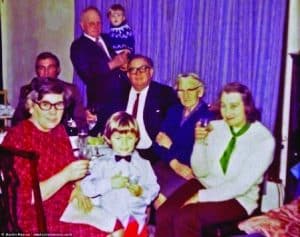
Two of Kerr’s close friends and fellow victims were to die young. One of them, Stephen Waring, couldn’t take any more of the brutality and horror, and committed suicide in 1977 by jumping into the sea during a trip on the Liverpool-Belfast Monarch Ferry. There were other victims who died.
The Anglo-Irish Vice Ring
Kerr’s social workers – who are still alive – furnished details about the abuse to Peter McKenna of the Irish Independent. It took a while but he eventually exposed the scandal in January 1980. By this time, Kerr had been trafficked to England by Eric Witchell.
The notorious paedophile, Sir Cyril Smith MP, was one of those who abused Kerr in Manchester. In London he was abused at the Philbeach Hotel in Earl’s Court; raped at Dolphin Square; and brought to Elm Guest House (EGH) which was frequented by Cyril Smith, Jimmy Savile and others. He was abused by a barrister at EGH. Hilton Tims, Editor of the Surrey Comet, 1980- 1988, has revealed that in the 1980s one of his journalists made inquiries about EGH only to receive a national security D-Notice injunction which shut his probe down. What possible “national security” threat was there in a story exposing a child brothel? Why did a judge issue the D-Notice?
Sir Peter Hayman, the Deputy Chief Of MI6
Sir Peter Hayman, KCMG, CVO, MBE was another of Richard Kerr’s abusers. Hayman rose to become High Commissioner to Canada and also worked for MI6. According to a slew of reports, he served as MI6’s Deputy Chief for a spell. He was also a member of the notorious Paedophile Information Network.
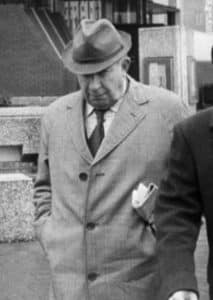
In October 1978 London detectives discovered his collection of child pornography: 45 of his diaries describing six years of “sexual fantasies” about children; and that he was a member of a group which swapped photographs. One of them shared fantasies about torturing children to death, with yet another paedophile. The police prosecuted two of them while Hayman was given a warning not to send obscene material through the post. In March 1981, Geoffrey Dickens, a Tory MP, named him in the House of Commons. Margaret Thatcher’s Attorney-General, Sir Michael Havers, argued that Hayman’s collection was not of an extreme nature and hence he had not warranted prosecution.
Despite all the chances he was given, Hayman failed to curb his impulses and was arrested in a public lavatory in London in 1984 with a boy and convicted of gross indecency – but let off with a caution.
The RUC perverts the course of justice
Kerr has told Village how, “detectives from the RUC also interviewed me in January of 1980 in Preston, Lancaster. I was taken out of the place and threatened when they got me to the police station. Because of their threats I was scared to tell them anything. I kept my mouth shut knowing that the abusers I met were still in contact with me, and the police put me in a cell and made me feel that I was responsible for what happened as if I was the guilty person”.
Kerr later moved to London where other detectives – this time not from the RUC – visited his home, “and did the same thing. They intimidated me and wanted me to not speak any more about what happened. So you can understand why I was scared because they always tried to make me feel I was responsible. I knew too much about what was going on, and the people that were involved – who I became afraid of”.
A bell hop who was able to live beyond his means
In London, Kerr secured work as a “bell hop” at the Cumberland Hotel near Marble Arch in London. As the pressure built up around the Kincora scandal in the early 1980s, the people behind the cover-up adopted a policy of carrot and stick to contain Kerr. By way of carrot, his financial security was assured: he was able to afford to live in Flat Number 1, 44 Baker St, around the corner from Oxford Street. Kerr has furnished Village with documentation which confirms he lived there. There was no conceivable way a teenage “bell hop” from Belfast could have afforded such a desirable residence without considerable financial assistance.
By way of stick, the intimidation continued: a group of men came to his flat at 44 Baker St. Some were in police uniform, others in civilian clothing. They knocked him to the ground, told him that they were from the British “Secret Service” and that he was to keep quiet about what he knew or they would arrest him as a ‘terrorist’.
The hard-cop-soft-cop routine was also deployed: the next day he received an apology for the rough treatment he had experienced.
Paisley throws his weight about at the Cumberland Hotel
One evening Kerr was at the bell hops’ station at the Cumberland Hotel when a colleague from the hotel’s café strolled across and told him someone was looking for him. The visitor turned out to be Ian Paisley. Kerr’s recollection of what would unfold is vivid and sharp: Paisley was seated on his own at a table “near a glass area” and was “wearing a suit with a hat that was placed on the table”. He also “carried a newspaper” which he “placed on the table”. A pair of men sat adjacent to him “in professional dress”. While Kerr recognised Paisley, he did not know the others. They would not address him at any stage during the encounter that ensued. “They created space between themselves and others”. As Kerr recalls it: “Paisley spoke with them; they were in earshot of our conversation. I was unable to discern if they spoke in an English accent. I do know that they were accompanying Paisley because they joined him after our conversation was complete”.
Paisley asked Kerr “to be seated after I was speaking with him standing up”. At the start “of the conversation I did not feel intimidated, yet as the meeting continued, I did begin to feel uneasy”, Kerr recalls.
Paisley knew he had been at Kincora and instructed him that if he was questioned by the police, he was not to “mention anything about Englishmen at Kincora”. Kerr was dumbfounded and responded “What?” Paisley repeated the instruction and added that he was “not [to] speak of other events that occurred in Belfast”.
“I nodded my head. No verbal communication was made”. The encounter only lasted about ten minutes. Paisley left with the two men. “I then went back to the bell station slightly disturbed and I did not respond to another bell boy’s question of the encounter”.
Kerr’s impression of the other men was that they had behaved “normally [and] they didn’t appear to be threatening”. Initially he had not been frightened by them as “they did not speak to me. It wasn’t until later that evening after the meeting [had ended] did I begin to feel concerned as to their intentions”.
- How did Paisley know that Kerr had been in Kincora?
- Who told him Kerr was working at the Cumberland?
- Who told Paisley “Englishmen” had abused children at Kincora?
- Why was Paisley prepared to help protect English paedophiles?
- Who were the men who accompanied him?
The following week a white envelope arrived at the hotel. It contained black-and-white photographs of Kerr, naked. The manager of the hotel, a Mr Gardner, showed them to Kerr who was deeply embarrassed and made an excuse that they must have been posted by a jealous ex-girlfriend. Gardiner let Kerr know that he was not pleased but didn’t dismiss him.
Who were the Englishmen Paisley strove to protect?
Clint Massey, another Kincora survivor, revealed in 2015 that “there were loads of people over from London. I have always assumed they were senior figures from Whitehall. I certainly heard English accents”.
The whistle-blower Robin Bryans (See Village October 2017) knew a lot of them, including Anthony Blunt of MI5. Another was a “decidedly gay-looking” man called Peter England. Bryans told this author in 1990 that while he knew England “very well” he “didn’t like him much”.
England was a former boyfriend of Sir Samuel Knox Cunningham QC MP and had also had a relationship with the Irish publisher, Charles Monteith, both members of the Anglo-Irish Vice Ring.
Peter England lived in London, had served in the Royal Navy during WWII and later went to work at the Ministry of Defence (MoD). He transferred to the Northern Ireland Office in the 1970s. Declassified files furnished to the Hart Inquiry demonstrated that some of his work involved oversight of the black propaganda activities of the Army and intelligence services. According to Bryans, “the main thing to do with covering up for Kincora” related to England. This analysis makes perfect sense because England: 1) had died in 1978 and therefore could be named without fear of a libel action; 2) had a criminal record: he had been arrested and convicted for obscene behaviour in a London toilet; 3) his exposure would have blown the Kincora cover-up wide apart, for it would have demonstrated knowledge of the scandal at the highest level of the NI O and made a nonsense of the claim that Kincora was an isolated aberration.
The late Merlyn Rees, a former Secretary of State for NI , worked with England at the NI O. In his NI memoirs, Rees described how England was: “a man of wide experience at the [MoD], whose work over the next three years [in Belfast] was to prove invaluable, though the physical stress of the job may have contributed to his tragically early death in 1978”. Moreover, he said that England “was a hard task master but at the same time he always showed concern for those working in the office”.
Clearly, England showed more “concern’”for his staff than for the children he abused. By the time of his death, Bryans recalled that England had let himself go and had become “scruffy”.
There is more: on 23 January 2015 the late journalist Liam Clarke reported in the Belfast Telegraph that two RUC officers had told him that a Tory MP had “visited Kincora during the 1970s”. Both officers, he reported, were “willing to help any inquiry into Kincora either here or in England. They revealed that the MP died before they could arrange to interview him”. There are only two MPs who match this description. One of the officers revealed that the MP had visited NI “quite regularly…We were told by criminal records in Scotland Yard, London, that he had a conviction many years ago for indecent behaviour or something in a gen ts’ loo against another boy, but his death meant we never got a chance to question him”.
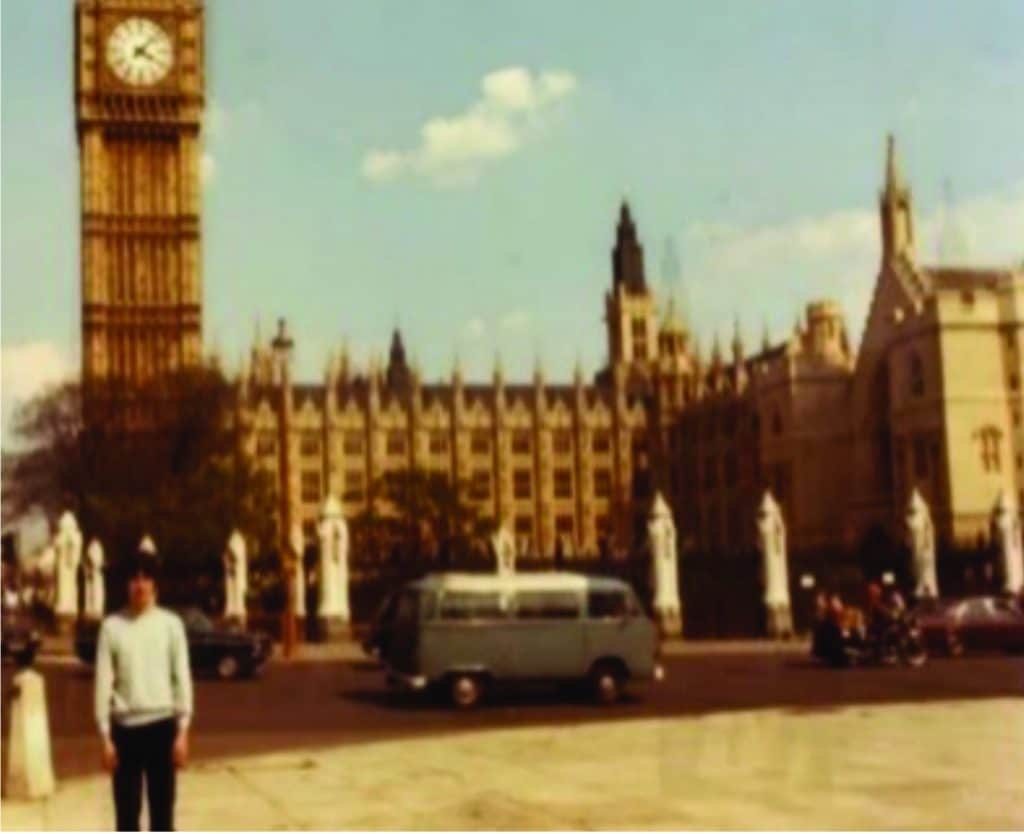
MPs, VIPs and celebrity child molesters in London
While Kerr was living in London, he continued to suffer abuse. At the time he was a teenager, but it mattered little to the abusers that he had been groomed, brutalised and desensitised since the age of eight.
Kerr has supplied Village with the name and address of a high-profile celebrity abuser who is alive and still enjoys public acclaim and affection. He has appeared in many successful British TV programmes, including one watched by millions of viewers in recent years.
There were other VIP abusers of Kerr including a Tory MP who, although no longer serving in Parliament, maintains a high profile. He has endeavoured to cast doubt about the existence of a VIP vice ring during the last few years. Village believes it is highly likely he is one of the main protagonists behind the ongoing cover-up and is acting in tandem with a dubious journalist who has done a lot to introduce misleading information to the public, all of which tends to undermine the credibility of genuine victims, like Kerr.
Returning to the 1980s: Kerr had become a serious threat to the cover-up of the truth about Kincora. One solution would have been to have had him murdered. Howard Smith, the then Direcor General of MI5, was – according to UK declassified files – an advocate of political assassination (See Village July 2017). John McKeague would have been an ideal choice as a hit man. However, by then Kerr’s murder would have caused too many waves because he had crossed paths with too many VIPs who hardly wanted the police knocking on their doors. In the end the conspirators opted to spirit him out of the country.
Who were Paisley’s ultimate puppet masters?
McGrath had multiple connections to Paisley – as had McKeague. McKeague had converted to the Paisley brand of Free Presbyterianism in 1966, and acted as Paisley’s bodyguard for a time. He was pivotal to the UVF bombing campaign that helped topple NI PM Terence O’Neill in 1968. He was also involved in the Ulster Protestant Volunteers, an organisation Paisley helped to set up in the 1960s.
During the 1960s while they were close to Paisley, McGrath and McKeague were involved 1) in the UVF; 2) the anti-O’Neill bomb campaign; 3) arms procurement; and 4) no end of hate crimes, not to mention child abuse.
The Cumberland Hotel incident seems to demonstrate that Paisley had been got at, most likely by incriminating information possessed by McGrath and McKeague. Since they were British assets, it is legitimate to ask: did one or both of them turn the screws on Paisley to get him to intimidate Kerr; moreover, did they do so with the support of Ian Cameron; Sir Howard Smith, D-G of MI5 1979-81; his deputy Sir John Jones (who became D-G, 1981-85); and others in MI5; not to mention Sir Maurice Oldfield and his MI6 cronies?
The tip of a chilling iceberg
For a while Richard Kerr co-operated with the Hart Inquiry to which he was a central witness. However, in the end he withdrew. His solicitors KRW Law said: “The State bodies/agencies that are Core Participants to the inquiry appear to have been provided with bundles of documents of up to 16,000 pages. In contrast, Mr Kerr was provided with around 740 pages.
“It is not clear why the inquiry wish to conceal these documents from Mr Kerr or his legal representatives. In the context of an inquiry that is investigating allegations that the British security forces and security services knew that abuse was and would be perpetrated on the children in Kincora and covered this up, this is inherently unreasonable”.
Richard Kerr now lives in Dallas where he has made many enduring friends and has received support, counselling and encouragement from a variety of kind and generous people all of whom he values enormously including Casey Gates. Nonetheless, he is angry at his former abusers, and the mind games they played with him as a child. He has benefited from years of counselling and is now determined to tell his story. Above all else he wants to achieve “a little justice” for those who died. He has a lot more to reveal. What appears in these pages is merely the beginning.
